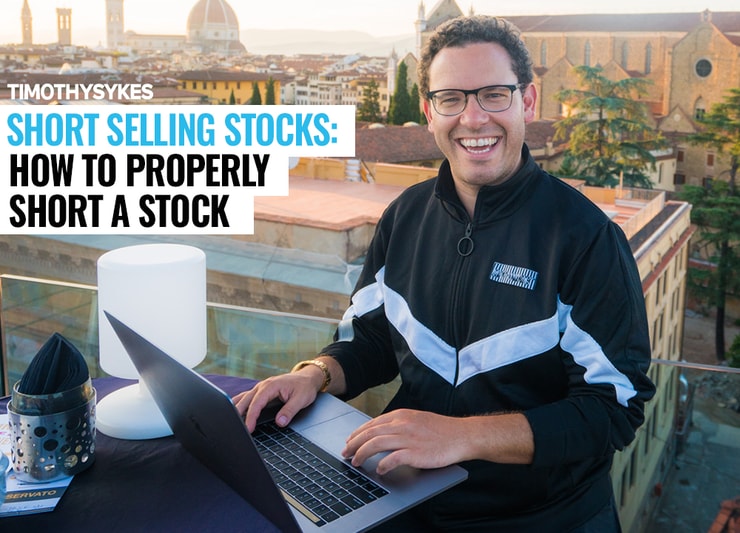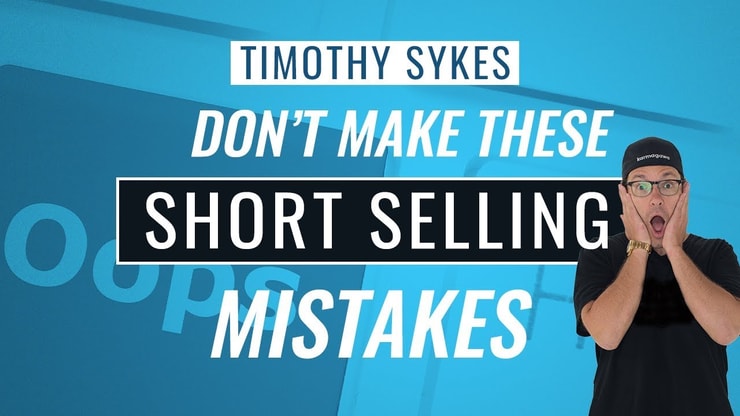As I’ve mentioned before, short sellers are often longs’ best friends. They spike up stocks far above what they’re worth! I thank them repeatedly for enriching me and several of my top trading challenge students.
Short selling is one of my favorite ways to make money in the stock market.**
If you’re fairly new to trading, the notion of short selling may seem particularly daunting — or even downright scary. But short-selling is not something to be feared. It’s a tool you can learn and use to help round out your trading activities and take advantage of situations when you’re better off betting on a stock’s decline in price.
However, I don’t recommend shorting stock just because you can or because you think I’m telling you to short everything that comes your way. Far from it.
Instead, you need to master the concept of shorting a stock and learn to recognize repeating patterns that could help you forecast price movement. Otherwise, you’re bound to lose money.
I’m getting ahead of myself, though. What is short selling? How does it work? And how can you potentially use it to your advantage? Let’s take a deep dive into this sometimes confusing topic.
Table of Contents
What Is Short Selling?

JRJC —damn! Perfect action for Short selling is the act of betting against a stock with the goal to generate a profit. When you go long, you bet on the stock’s price rising until you sell it. That’s a long position. A short position occurs when you believe a stock’s price will move against what others assume.
Let’s say that lots of people are buying up a stock we’ll call XYZ, for example. There’s a promotion going on that you’ve identified, so you predict a major crash once people start dumping their stock. By short selling that stock, you could possibly profit from the price’s eventual decline.
This wouldn’t work outside financial instruments. Imagine borrowing your buddy’s car because you believe its market value will decline swiftly in the near future. You sell the car out from under him and pocket the cash. Later, when the market value falls, you buy an identical car and return it to him.
You probably wouldn’t have a friend anymore.
It’s all fair in the stock market, though, so you have to be willing to seek out patterns different from traditional longs.
How Does Short Selling Work?
Short selling is a four-step process:
- Decide how many shares you want to short. You borrow those shares from your broker for a fee. There’s no limit to the number of shares you can short as long as you have the cash available.
- Sell the shares you borrowed. Ideally, you’ll sell the shares close to the top of a spike. This often happens when unscrupulous promoters convince people to buy shares in a stock for no reason at all.
- Buy back the stock. When the price declines, you want to buy back the shares at a lower stock price. Don’t wait too long — take your profits early to avoid potential losses.
- Return the shares. The shares you shorted go back to your broker. You pocket the difference.
Obviously, there’s risk in short selling stock — I’ll cover that later — but every stock market play contains some element of risk. You have to study and practice over months and years so the effective patterns become easy for you to spot.
Short Selling as a Daunting Task
Why does short selling seem so daunting?
Well, like most seemingly daunting tasks, short selling is not daunting in itself. To be honest, it’s the idea of short selling that has become scary for many investors. People have it stuck in their head that short selling is something to avoid.
It’s too complicated, too risky, too labor-intensive.
People have created this mental barrier, shielding themselves from something that could prove to be quite lucrative simply because they don’t know enough about it, and they don’t know where to start. And once someone has made their mind up about something, it can be difficult to change that perception.
Add to that the multitude of perhaps well-intentioned internet posts that spew gloom and doom with regard to short selling — “Why You Should Never Short-sell Stocks” or “How to Short Sell Stocks and Why You Shouldn’t” — and you have a perfect storm that has effectively demonized this trading strategy.
But if used prudently, short-selling can indeed prove useful, particularly in a bear market and when betting against penny stock scams like these.
Benefits of Using Short Selling
If you only take long positions during your trading activities, you can only benefit when you’re bullish on a stock. If you’re bearish, you don’t trade.
Short selling eliminates that conundrum. I’m not saying you should trade every day — you probably shouldn’t unless there are tons of amazing plays — but what if there are no decent long positions?
You start looking for short selling opportunities.
Traders who avail themselves of short selling can potentially profit in both bear and bull markets. When you’re bearish on a stock and you have good information behind your sentiment, shorting it allows you to trade even though there are no stocks you want to buy.
Short Selling Example
I provided the example of the car you shorted off your friend earlier, but let’s look at a more direct analogy.
We’ll start with a long position. Kim wants to buy five marbles. The going rate for marbles is $2 each, so she pays Sarah $10 for her five marbles. A day later, marbles are selling for $3 each. Now Kim sells her five marbles to Jack for $15 — a profit of $5. That’s an easy analogy for a regular purchase.
Now, let’s look at a short sale (of marbles): Kim thinks the price of marbles is going to plummet because marble demand is expected to decrease tomorrow. The going rate is $2 each today, but she thinks that by tomorrow, marbles will be worth $1 or less.
Kim knows there is still a way to profit from the future price fall: she can short it. Kim goes to the bank and tells the bank of her plan. The bank knows a customer — Mike — who has marbles. The bank borrows Mike’s five marbles and sells the marbles on the market for $10 to Kim. The bank puts the $10 from the sale of the marbles in Kim’s bank account.
The next day, marble prices halve. Kim calls the bank to “cover” her position — meaning she will now buy five marbles from the market (from her account of $10) at today’s price of $1 each, or $5 total. The five marbles are then returned to their rightful owner, Mike.
In a tiny nutshell, short selling involves borrowing a stock and selling it, and then buying the stock (hopefully at a lower price) and returning it to the owner — pocketing the difference. That’s borrow it, sell it, buy it, return it: four steps.
Limitations of Short Selling Stocks
So, if short selling can prove so profitable, why is there so much trepidation among traders? As I mentioned above, short selling involves inherent risks. Let’s look at the four most concerning risks and figure out how to overcome them.
#1 Endless Risk
Unlike regular trading, short selling comes with infinite risk. Yep: infinite. In theory, the price of marbles, after you borrowed them and sold what you didn’t own, could go up — and up, and up, even to infinity. You could be left covering an infinite gap between what you sold it for and whatever price it reaches. And the bank (your broker) could demand that you cover that stock whenever it chooses.
All trading comes with risk, but with long positions, the lowest a price can go is zero, and since you bought it at a specific amount, the largest amount you can lose is the amount you paid for it.
Not that that’s a good thing. Betting $1 million on a stock and having it plummet to $0 is still horrific and risky. So, I’m not sure the notion that short selling comes with some untenable risk is entirely fair. But, mathematically speaking, the risk is endless — and can even extend beyond what you have. You could lose way more money than you have.
At least with long positions, the complete risk is known up front. Even when faced with losing everything, which is possible in any long position, there is some comfort in knowing the absolute maximum that you could lose.
That’s why you MUST follow rule #1 here on all short sells, no matter how much you hate the company/stock!
#2 Limited Returns
Normal stock trading comes with the possibility of infinite returns and limited risk. If you paid $5 for a stock, the most you can lose is $5 if the price falls to $0. In long positions, your profits are limitless — the price could theoretically go up and up into infinity, meaning that your profit-making opportunities are — at least in theory — limitless.
But in short selling, the inverse is true. The most you can make from shorting a stock is how much you put into it (or rather, how much you borrowed). So, for a $5 stock, the most you could possibly make is $5, and that’s a best-case scenario that would only happen if the stock becomes completely worthless and falls to $0.
Because the risk is endless and the rewards are capped at a specific amount, traders don’t always see short selling as a mouthwatering prospect, especially to the newer investor who is often looking for a small number of huge returns, rather than a large number of small gains over time.
#3 Not Every Stock Can Be Shorted
“No shares available.” This is a common response to an inquiry to short a certain stock.
In the marble example above, notice that the bank borrowed Mike’s marbles. Oddly enough, Mike is blissfully unaware of this five-finger lifting that would see his shares returned to him at a later date. Mike’s account is never affected — just the actual marbles removed — so it doesn’t actually show up on his statement.
But the only shares available for borrowing are held in margin accounts. Stock held in cash-only accounts are not available for borrowing, and therefore are not available to short sellers. Also, penny stocks (stocks under $5) cannot always be shorted either, and will vary depending on your broker.
Sometimes, you will get the “no shares available” message even when it’s possible to short the stock in question. You simply need to call your broker and ask whether any shares are available to short, and they will try to find them for you.
Also, note that some brokers will tell you — erroneously — that stocks under $5 cannot be shorted due to SEC rules. This is not so. You can read more about this here: Can You Short Sell Stocks Under $5?
The takeaway here is that the stock you are hoping to short will not always be available through your broker. You can likely have more opportunities if you work with multiple brokers.
#4 Covering May Not Be as Easy as You Think
Liquidity may be low, meaning that when you want to cover your position, you may not be able to find any shares to buy when you want to — let alone at the price you want.
Also, just because marbles were $2 each today doesn’t mean that tomorrow, they’ll be $3 before they hit $5, or $10. Tomorrow, they could be $20, and have skipped all the increments in between.
You may not be able to close out your position along the way because there may not be an “along the way.” Prices do not necessarily hit every (or any) point in between.
But it’s not all bad.
Important Metrics to Keep in Mind While Shorting a Stock
Short selling can prove profitable if you’re willing to learn the intricacies of this trading practice and study hard. I always tell my students to hit the books every day and to bury themselves in spreadsheets. The harder you work, the better your prospects for success.
Let’s look at a couple metrics you need to know before you consider shorting a stock.
Short Interest
Think of short interest as an expression of sentiment. It tells you whether other investors are bearish or bullish on a particular stock. It’s communicated as a number or percentage.
Essentially, short interest conveys the number of existing shorted shares that have not yet been covered. In other words, how many shares have investors already shorted?
You can decide how to proceed based on how many outstanding shares have been shorted and whether that number has increased or decreased over days or weeks.
Short Interest Ratio (SIR)
You also want to track SIR, which tells you the ratio of shorted shares to trading volume. Let’s say, for instance, that there are 10 million shorted shares and the average daily trading volume is 20 million shares. You have a ratio of 20 million to 10 million.
The reason this matters is that it tells you about how long it will take for all of those shorted shares to be covered. You just divide the first number by the second. In the example above, you divide 20 million by 10 million, which gives you two.
In this example, it would take two full trading days for all investors to cover their shorted shares.
How to Short a Stock
We’ve covered the basics, but how do you short a stock while reducing your exposure to the risks mentioned above? That’s the big question.
Remember That Timing Is Everything
If you’ve followed my career, you’ve likely seen pictures of me trading in all kinds of places, whether I’m lounging in a pool in a foreign country, sitting in my seat on a plane, or playing with wild animals.
That’s because I know that timing is everything.
When you time a short sale right, it’s possible to profit enormously. When you’re off by just a few minutes — or even seconds — the profit potential declines swiftly.
This is particularly true when you’re short selling based on panic. A promoter has gotten lots of ill-informed investors to buy shares in a given stock, but those investors start selling shares like crazy when they realize their positions aren’t going to hold. That’s a great setup for short selling, but only if you’re fast.
Stick to Your Trading Discipline
Just because you’re changing up your trading strategy doesn’t mean you should throw caution to the wind. That’s how investors lose money in the stock market.
Remember my number-one rule: Cut losses early. If the price action moves against you, cover as quickly as you can to limit your losses.
It’s true that there are situations in which you can’t find shares to buy. The way to avoid that as much as possible is to choose stocks with huge volume. When there’s lots of volume, you’ll cover your shares more easily.
Anticipate Declining Price Action
You need evidence before you try short selling. In other words, why might a stock’s price decline? You might have heard negative news about a company, seen a pump-and-dump scheme in action, or spotted a potentially lucrative pattern.
Whatever the case, there needs to be a catalyst. You shouldn’t short a stock just because you don’t like the company or because you’re itching to trade. That’s how you lose cash.
Best Broker for Short Selling
The best broker for short selling is the one that offers you the most flexibility. You want a broker that will seek out shares for you to short when you can’t find any on your own and one that will allow you to short penny stocks.
Robinhood, for example, is a free trading platform. Many people flock to it because they don’t have to pay commissions. However, it’s also severely limiting. You can’t short at all.
I also recommend working with multiple brokers if you can. That way, if you’re unable to short a stock with one, you can switch gears and find shares through a different broker.
Never Stop Learning
I’ve emphasized several times in this article that you must, above all else, prioritize research. If you’re not learning something new every day, you’re doing yourself a serious disservice.
Many people ask me why I continue to learn new patterns and discover new plays. Sure, I’ve been at this for decades, but that doesn’t mean I know everything. Far from it. I have to keep learning if I want to continue my career.
That goes for you, too.
Trading Challenge
What if you could learn in a dynamic, supportive environment? That’s exactly what the Trading Challenge offers. You don’t just learn from me. You also learn from my other students, several of whom are very successful traders.
If you don’t have to go it alone, why would you want to? Apply to join us. You could become my next success story.**
The Bottom Line
You don’t have to be afraid of short selling. A little fear is good because it keeps you conservative, but you don’t want to be overwhelmed by anxiety.
It starts with research. Reading this post was a good start. You’re gaining a broader understanding of how short selling works and whether shorting is a good fit for you.
Once you’ve mastered the concept, try paper trading. It’s a great way to get your feet wet. Many trading platforms, including StocksToTrade, offer paper trading, where you don’t have to risk real money. After a while, move on to actual trading. Once you’re ready, take off the training wheels and dive in … because, after all, if you want to profit from the stock market, you have to invest real money.
Maybe you’ve already had some success with long positions, but you’re ready to try your hand at shorting stocks. With lots of education and research, it could be a good fit for you.
If this all sounds appealing, it could be time to give shorting a shot!
Do you short sell stocks? Why or why not?






Leave a reply